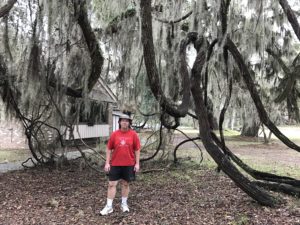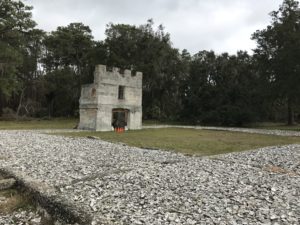Each national park site that Tom and I work at has its own distinctive emphasis and personality. This means that each national park site also has its own brand of visitors and visitor questions. I have discussed some of the unique questions that we get at each place in previous posts (Death Valley, Chickamauga, Kings Mountain, Grand Portage). I only have a couple of blog posts left about our time here at Fort Frederica, so I thought today would be a good time to write about some of our recent visitor questions.
The most common question at Fort Frederica is “Why is it called Frederica?” Usually a guest asks this after reading everything in the museum and sometimes after walking around the grounds. Nothing they read explains the name. The movie talks about it, but only half our visitors watch the movie. Fort Frederica was named after Crown Prince Frederick, the son of George II. Just as Georgia is the feminized version of George, Frederica is the feminized version of Frederick. Crown Prince Frederick died before his father, so Frederick’s son, George III, became king.
 Another common question is “What are those vines wrapped around the trees?” At Fort Frederica we have lots of live oak trees. There is plenty of spanish moss hanging from the live oaks. And there are large vines curled around and into the giant limbs of the spanish moss. These are muscadine vines – a kind of grape vine. The grape vines are as old as the trees they hang on, so some of the vines are over 150 years old.
Another common question is “What are those vines wrapped around the trees?” At Fort Frederica we have lots of live oak trees. There is plenty of spanish moss hanging from the live oaks. And there are large vines curled around and into the giant limbs of the spanish moss. These are muscadine vines – a kind of grape vine. The grape vines are as old as the trees they hang on, so some of the vines are over 150 years old.
 The last question, specifically related to Fort Frederica, is “Why did the settlers fill their foundations with shells?” The excavated foundations of the houses at Fort Frederica have a thick layer of oyster shells in them. The settlers didn’t put the shells in the foundations. The park did it to discourage people from walking on and in the delicate foundations. We put up signs which people ignore, but when we fill the foundations with shells, people stay off them. The shells also help keep the weeds down inside the foundations.
The last question, specifically related to Fort Frederica, is “Why did the settlers fill their foundations with shells?” The excavated foundations of the houses at Fort Frederica have a thick layer of oyster shells in them. The settlers didn’t put the shells in the foundations. The park did it to discourage people from walking on and in the delicate foundations. We put up signs which people ignore, but when we fill the foundations with shells, people stay off them. The shells also help keep the weeds down inside the foundations.
People often come into the Visitors Center wanting to buy a Senior Pass, especially after AARP and Southern Living both ran articles about the pass going from $10 to $80 sometime this year. So a common question is “Can I buy a Senior Pass?” Unfortunately, Fort Frederica does not deal with passes at all. When we stopped charging admission, about three years ago, they also decided not to carry any of the passes. We explain to people that they can buy the pass at any park that charges admission: Fort Pulaski an hour north or Cumberland Island an hour south both sell them. But people are understandably disappointed, especially when the NPS website mistakenly tells them they can buy the passes at any National Park Site.
There are two more common visitor questions that I get in the Visitors Center, but they don’t have to do with Fort Frederica or the National Parks. The first is “Can I drive to Sea Island?” Sea Island is one of the most expensive and exclusive places people can drive to and stay at in the United States. It is a privately owned island. Rooms start at $350 per night and prices work their way up to over $10,000 per night for a “cottage.”
The answer to this question is “No, you can’t drive to Sea Island.” It is a gated island and you must have a reservation or be on the list of visitors to get in. The guards at the gate are very good at turning people away. I noticed there was an Easter Brunch at the Cloisters and thought making a reservation would be a good way to see the island. The Easter Brunch cost $75 per person. A little more than I want to spend on some food.
The final question asked frequently by our guests is “Where is the beach?” People can find Fort Frederica – the National Monument has excellent signs. The beach, however, has no signs at all. Unless you know how to get to it, you won’t find it. You can drive down all the main roads and never find the beach. So trying to find the beach can be a frustrating experience. Fortunately people are really good about point out how to get there if you ask. The two main access points are East Beach Causeway and Massengale Park on Ocean Blvd. Once parked, you still have to walk over the dunes before you see the beach, so it is easy to understand why people can’t find the beach.
I love knowing the answers to our visitor questions. People come to a National Park to have fun and learn so questions are a good thing. Never be afraid to ask a ranger (or a volunteer) any questions you have. They have probably heard it before!
